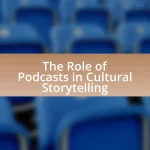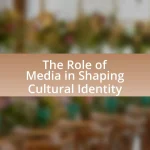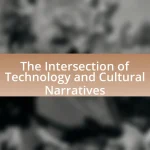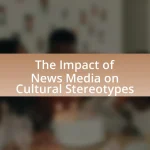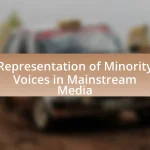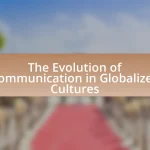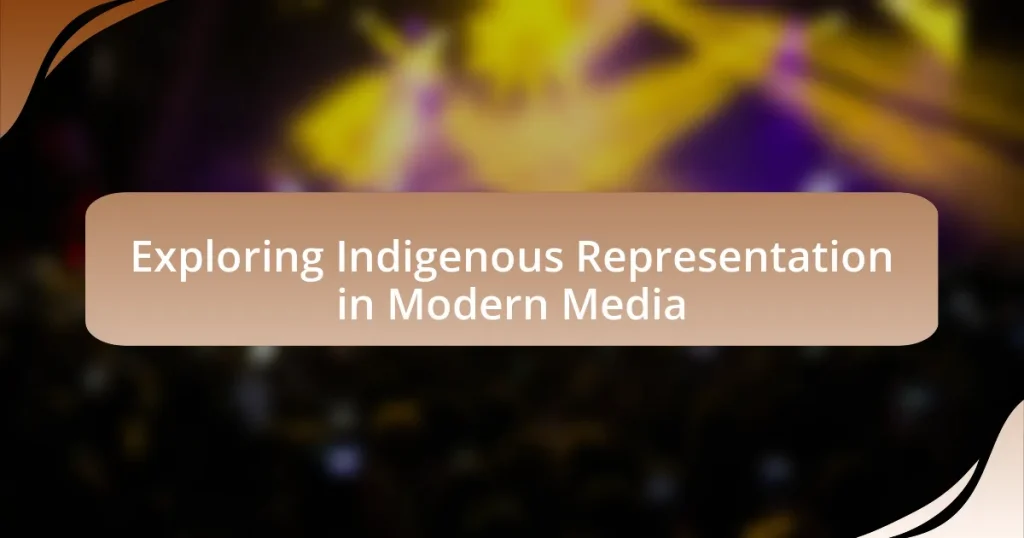Indigenous representation in modern media encompasses the portrayal and inclusion of Indigenous peoples, cultures, and perspectives across various media forms, including film, television, and literature. This representation is vital for challenging stereotypes, promoting cultural understanding, and providing authentic narratives that reflect the diversity of Indigenous experiences. The article examines the importance of accurate representation, its impact on Indigenous communities, the historical context shaping current portrayals, and the challenges faced, such as stereotyping and underrepresentation. It also highlights the evolving landscape of Indigenous storytelling, the role of Indigenous creators, and best practices for respectful representation, ultimately emphasizing the implications for cultural identity and social justice.
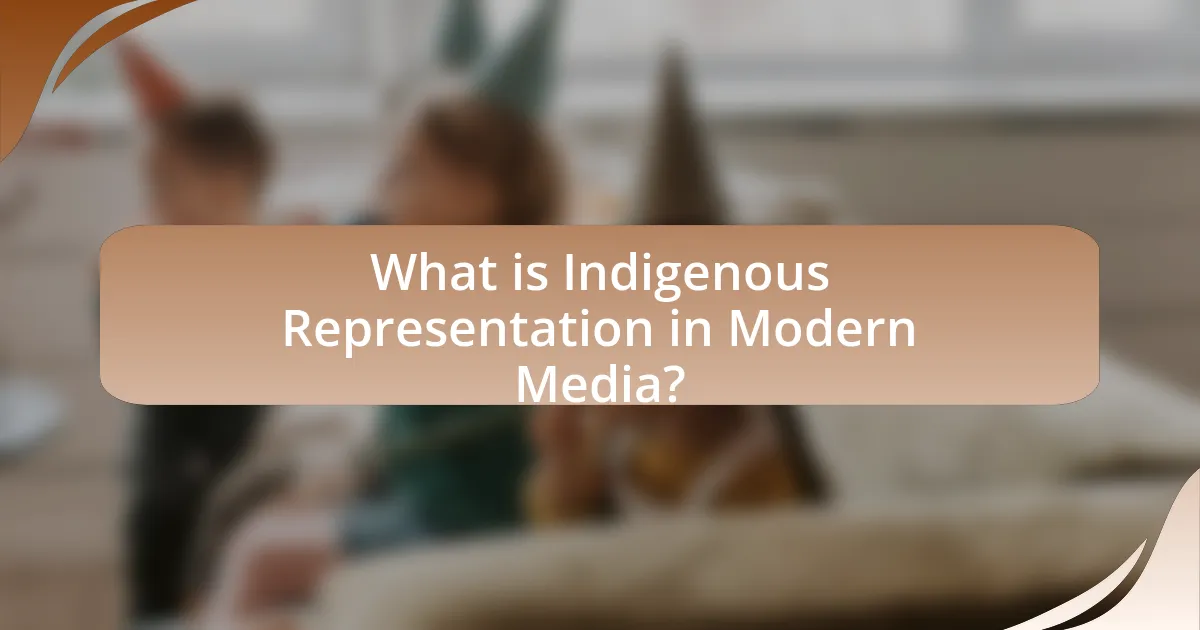
What is Indigenous Representation in Modern Media?
Indigenous representation in modern media refers to the portrayal and inclusion of Indigenous peoples, cultures, and perspectives in various forms of media, including film, television, literature, and digital platforms. This representation is crucial for challenging stereotypes, promoting cultural understanding, and providing authentic narratives that reflect the diversity and richness of Indigenous experiences. Research indicates that accurate representation can lead to increased visibility and respect for Indigenous communities, as seen in projects like “Rutherford Falls” and “Reservation Dogs,” which feature Indigenous writers and actors, thereby fostering a more nuanced understanding of Indigenous life.
Why is Indigenous representation important in contemporary media?
Indigenous representation is important in contemporary media because it fosters cultural understanding and combats stereotypes. Accurate portrayals of Indigenous peoples contribute to a more inclusive narrative, allowing diverse audiences to engage with their histories and perspectives. Research indicates that representation can significantly influence public perception; for instance, a study by the Annenberg Inclusion Initiative found that increased visibility of marginalized groups in media leads to greater empathy and awareness among viewers. Furthermore, Indigenous representation empowers Indigenous communities by validating their identities and experiences, which is crucial for cultural preservation and social justice.
How does representation impact Indigenous communities?
Representation significantly impacts Indigenous communities by shaping public perceptions and influencing cultural narratives. Accurate and respectful representation in media can foster understanding and appreciation of Indigenous cultures, while misrepresentation can perpetuate stereotypes and marginalization. For instance, studies have shown that when Indigenous peoples are portrayed authentically in films and television, it can lead to increased awareness and support for their rights and issues, as evidenced by the positive reception of films like “Smoke Signals” and “The Fast Runner,” which highlight Indigenous stories and perspectives. Conversely, negative portrayals can contribute to systemic discrimination and social injustices faced by these communities.
What historical context shapes current Indigenous representation?
The historical context that shapes current Indigenous representation includes colonization, forced assimilation policies, and the ongoing struggle for rights and recognition. Colonization led to the marginalization of Indigenous cultures and identities, as seen in the establishment of residential schools in Canada and the United States, which aimed to erase Indigenous languages and traditions. These historical injustices have resulted in a contemporary landscape where Indigenous voices are often underrepresented or misrepresented in media. The Indian Act in Canada and similar legislation in other countries further institutionalized discrimination, impacting how Indigenous peoples are portrayed. Recent movements advocating for Indigenous rights and sovereignty, such as the Truth and Reconciliation Commission in Canada, have prompted a reevaluation of representation, pushing for more authentic and diverse portrayals in modern media.
What are the key challenges faced in Indigenous representation?
The key challenges faced in Indigenous representation include stereotyping, lack of authentic voices, and underrepresentation in decision-making roles. Stereotyping often leads to the portrayal of Indigenous peoples in a narrow and inaccurate manner, which can perpetuate harmful myths. The lack of authentic voices arises when Indigenous individuals are not involved in the creation of their narratives, resulting in misrepresentation. Additionally, underrepresentation in media and decision-making roles limits the opportunity for diverse and accurate storytelling, as evidenced by a 2019 report from the Annenberg Inclusion Initiative, which found that only 3% of film directors were Indigenous. These challenges hinder the accurate portrayal of Indigenous cultures and experiences in modern media.
How do stereotypes affect Indigenous portrayal in media?
Stereotypes significantly distort Indigenous portrayal in media by perpetuating narrow and often negative representations. These stereotypes, such as depicting Indigenous people as either noble savages or alcoholics, limit the complexity of their identities and experiences. Research indicates that such portrayals contribute to public misconceptions, leading to a lack of understanding and empathy towards Indigenous cultures. For instance, a study by the Canadian Broadcasting Corporation found that 80% of Indigenous individuals felt that media representations do not accurately reflect their realities, reinforcing the harmful impact of stereotypes on societal perceptions.
What role does cultural appropriation play in media representation?
Cultural appropriation plays a significant role in media representation by often misrepresenting or commodifying the cultural elements of marginalized groups, particularly Indigenous communities. This appropriation can lead to stereotypes and a lack of authentic representation, as seen in films and television shows that depict Indigenous cultures without input from Indigenous creators. For example, the film “Avatar” has been criticized for borrowing heavily from Indigenous aesthetics while failing to include Indigenous voices in its storytelling process. Such practices can perpetuate harmful narratives and diminish the cultural significance of the appropriated elements, ultimately impacting how these communities are perceived in society.
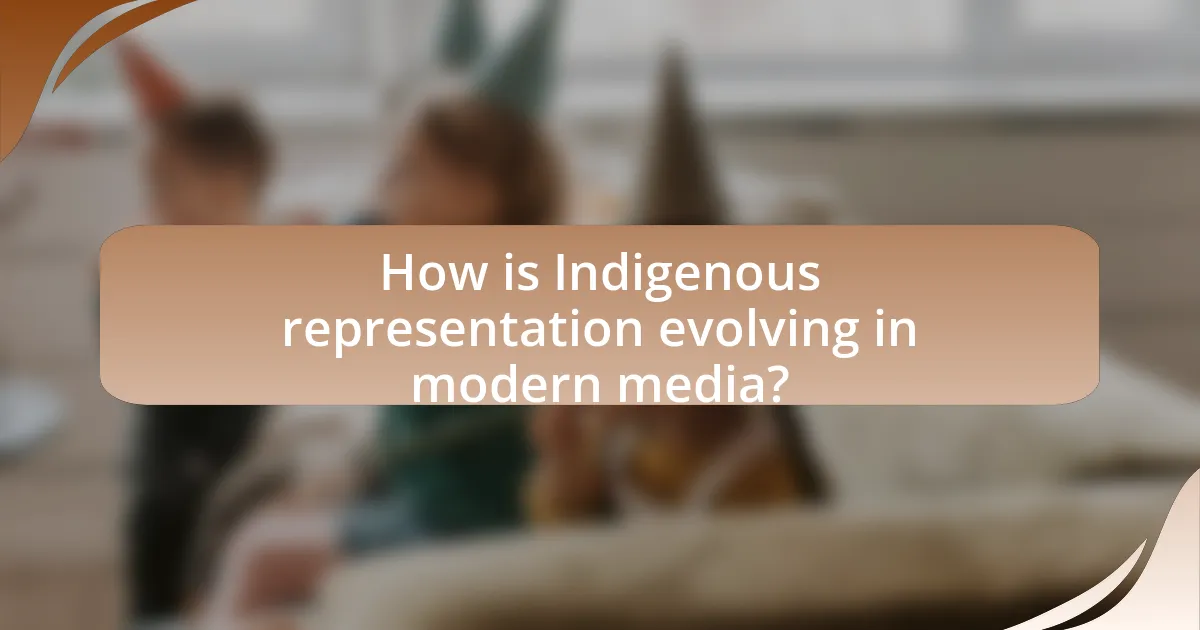
How is Indigenous representation evolving in modern media?
Indigenous representation in modern media is evolving through increased visibility, authentic storytelling, and the involvement of Indigenous creators. This shift is evident in the rise of films and television series that feature Indigenous narratives, such as “Rutherford Falls” and “Reservation Dogs,” which are produced by Indigenous filmmakers and writers. These productions not only showcase Indigenous cultures but also challenge stereotypes and provide a platform for Indigenous voices. According to a 2021 report by the Annenberg Inclusion Initiative, there has been a notable increase in the representation of Indigenous characters in film and television, reflecting a broader societal recognition of the importance of diverse narratives. This evolution signifies a move towards more accurate and respectful portrayals of Indigenous peoples, contributing to a richer media landscape.
What are the current trends in Indigenous storytelling?
Current trends in Indigenous storytelling include the use of digital platforms, collaborative narratives, and a focus on cultural revitalization. Digital platforms, such as podcasts and social media, allow Indigenous voices to reach wider audiences, enabling the sharing of traditional stories in contemporary formats. Collaborative narratives involve partnerships between Indigenous creators and non-Indigenous media, fostering authentic representation and mutual respect. Additionally, there is a strong emphasis on cultural revitalization, where storytelling serves as a means to preserve languages and traditions, as seen in initiatives like the First Nations Language and Culture Centre’s storytelling programs. These trends reflect a growing recognition of the importance of Indigenous perspectives in modern media.
How are Indigenous filmmakers and creators influencing media narratives?
Indigenous filmmakers and creators are significantly influencing media narratives by centering Indigenous perspectives and stories, thereby challenging dominant cultural representations. They are reshaping narratives through authentic storytelling that reflects their lived experiences, cultural heritage, and contemporary issues. For instance, films like “Rhymes for Young Ghouls” and “Smoke Signals” have garnered critical acclaim for their nuanced portrayals of Indigenous life, moving beyond stereotypes and offering complex characters. Additionally, initiatives such as the Indigenous Screen Office in Canada support Indigenous creators, ensuring that their voices are amplified in the industry. This shift not only enriches the media landscape but also fosters greater understanding and respect for Indigenous cultures among broader audiences.
What platforms are most effective for Indigenous voices today?
Social media platforms, particularly Facebook, Instagram, and Twitter, are most effective for Indigenous voices today. These platforms enable Indigenous individuals and communities to share their stories, culture, and perspectives directly with a global audience. For instance, the use of hashtags like #IndigenousPeoples and #MMIW (Missing and Murdered Indigenous Women) has mobilized awareness and advocacy, reaching millions and fostering community engagement. Additionally, platforms like YouTube allow for the dissemination of Indigenous-led content, showcasing cultural practices and narratives that might otherwise be marginalized in mainstream media. The effectiveness of these platforms is evidenced by the significant increase in visibility and support for Indigenous issues, as seen in various campaigns and movements that have gained traction online.
How do audiences perceive Indigenous representation in media?
Audiences perceive Indigenous representation in media as a critical issue that significantly impacts cultural understanding and identity. Research indicates that when Indigenous peoples are portrayed authentically and respectfully, audiences tend to respond positively, recognizing the importance of accurate representation in fostering empathy and awareness. For instance, a study by the Annenberg Inclusion Initiative found that films featuring Indigenous characters often lack depth and complexity, leading to stereotypes that can perpetuate misunderstanding. Conversely, media that showcases Indigenous narratives from Indigenous perspectives, such as the series “Rutherford Falls,” has been praised for its nuanced portrayal, demonstrating that audiences appreciate and support content that reflects genuine Indigenous experiences.
What are the reactions of Indigenous audiences to their portrayal?
Indigenous audiences often react negatively to their portrayal in media, expressing concerns about stereotypes and inaccuracies. Many Indigenous viewers report feeling marginalized and misrepresented, as media often perpetuates harmful clichés rather than showcasing authentic narratives. Research indicates that 78% of Indigenous respondents in a study by the Annenberg School for Communication noted that they feel underrepresented or misrepresented in film and television. This highlights a significant disconnect between Indigenous experiences and mainstream media portrayals, leading to calls for more accurate and diverse representation.
How does non-Indigenous audience perception affect representation?
Non-Indigenous audience perception significantly influences the representation of Indigenous peoples in media. When non-Indigenous viewers hold stereotypes or misconceptions about Indigenous cultures, media creators may cater to these views, resulting in oversimplified or inaccurate portrayals. For example, a study by the Canadian Broadcasting Corporation found that Indigenous characters are often depicted in roles that reinforce stereotypes, such as the “noble savage” or the “drunken Indian,” which can perpetuate harmful narratives and limit the diversity of Indigenous stories told. This skewed representation can further entrench biases and affect public understanding of Indigenous issues, leading to a cycle where media representations do not reflect the true complexity of Indigenous identities and experiences.
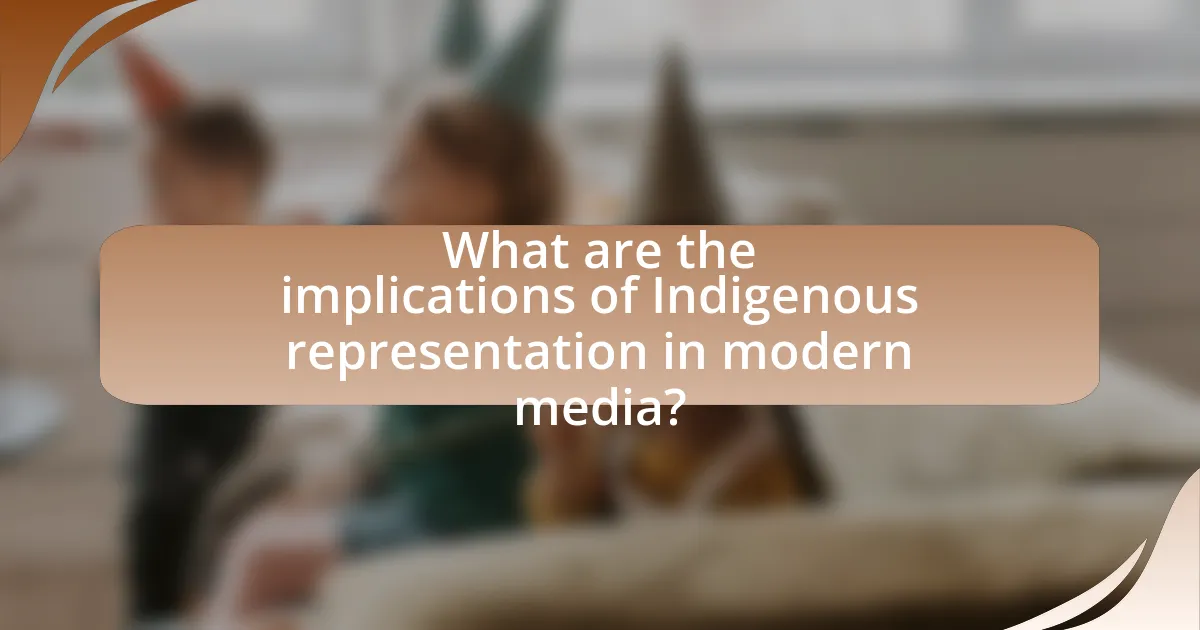
What are the implications of Indigenous representation in modern media?
Indigenous representation in modern media significantly impacts cultural identity, social perception, and political advocacy. Accurate and diverse portrayals of Indigenous peoples can foster understanding and respect, countering stereotypes that have historically marginalized these communities. For instance, the success of shows like “Reservation Dogs” and films such as “Smoke Signals” highlights the importance of authentic storytelling, which can lead to increased visibility and empowerment for Indigenous voices. Furthermore, studies indicate that positive representation can influence public attitudes, reducing prejudice and promoting social justice initiatives. Thus, the implications of Indigenous representation extend beyond entertainment, shaping societal narratives and contributing to the broader discourse on equity and inclusion.
How does representation affect Indigenous identity and culture?
Representation significantly influences Indigenous identity and culture by shaping perceptions and narratives within society. Accurate and respectful representation in media can affirm Indigenous identities, promote cultural pride, and challenge stereotypes, while misrepresentation can perpetuate harmful myths and marginalize Indigenous voices. For instance, studies have shown that positive portrayals of Indigenous peoples in film and television can lead to increased understanding and respect among non-Indigenous audiences, as evidenced by the success of productions like “Rutherford Falls,” which highlights contemporary Indigenous experiences. Conversely, negative stereotypes in media can contribute to societal biases and discrimination, undermining the rich diversity of Indigenous cultures. Thus, representation plays a crucial role in either reinforcing or dismantling cultural narratives surrounding Indigenous communities.
What role does media play in preserving Indigenous languages and traditions?
Media plays a crucial role in preserving Indigenous languages and traditions by providing platforms for their expression and dissemination. Through television, radio, and digital content, Indigenous communities can share their languages, stories, and cultural practices, fostering intergenerational transmission. For instance, initiatives like the “First Nations Language Program” in Canada have successfully utilized media to revitalize languages at risk of extinction, demonstrating that media can effectively engage younger audiences and promote cultural pride. Furthermore, research indicates that media representation of Indigenous cultures can enhance visibility and understanding, countering stereotypes and fostering respect for their traditions.
How can media representation foster understanding and reconciliation?
Media representation can foster understanding and reconciliation by accurately portraying the experiences, cultures, and histories of Indigenous peoples, thereby challenging stereotypes and misconceptions. When media outlets present diverse and authentic narratives, they create opportunities for audiences to engage with and empathize with Indigenous perspectives. For instance, the documentary “Rumble: The Indians Who Rocked the World” highlights the contributions of Indigenous musicians, which not only educates viewers about their cultural significance but also promotes a deeper appreciation and respect for Indigenous identities. This kind of representation can lead to increased awareness and dialogue, ultimately contributing to reconciliation efforts by bridging gaps between Indigenous and non-Indigenous communities.
What best practices can be adopted for better Indigenous representation?
To achieve better Indigenous representation, media organizations should prioritize collaboration with Indigenous communities in content creation. This practice ensures that narratives are authentic and reflect the lived experiences of Indigenous peoples. For instance, the inclusion of Indigenous writers, directors, and consultants in film and television projects has been shown to enhance the accuracy and depth of representation, as evidenced by the success of productions like “Rutherford Falls,” which features Indigenous voices in its storytelling process. Furthermore, implementing training programs for non-Indigenous creators about Indigenous cultures and histories can foster understanding and respect, leading to more nuanced portrayals. Research indicates that when Indigenous people are involved in the storytelling process, it results in more positive perceptions and greater acceptance among audiences.
How can media creators collaborate with Indigenous communities effectively?
Media creators can collaborate with Indigenous communities effectively by prioritizing respectful engagement and co-creation processes. This involves establishing trust through open communication, recognizing the cultural significance of Indigenous narratives, and ensuring that community members have a central role in the storytelling process. For instance, the “Indigenous Media Fund” supports projects that are led by Indigenous creators, ensuring that their perspectives are authentically represented. Additionally, adhering to the principles outlined in the “Guidelines for Ethical Research in Indigenous Communities” can help media creators navigate cultural sensitivities and foster genuine partnerships.
What guidelines should be followed to ensure respectful representation?
To ensure respectful representation of Indigenous peoples in modern media, creators should prioritize authenticity, collaboration, and cultural sensitivity. Authenticity involves accurately portraying Indigenous cultures, histories, and languages, often by involving Indigenous voices in the storytelling process. Collaboration with Indigenous communities ensures that their perspectives and narratives are represented accurately and respectfully. Cultural sensitivity requires understanding and respecting the significance of cultural symbols, practices, and traditions, avoiding stereotypes and misrepresentations. Research indicates that media projects that engage Indigenous consultants and creators lead to more accurate and respectful portrayals, as seen in the success of films like “Smoke Signals,” which was co-written and directed by Indigenous filmmakers.
What resources are available for understanding Indigenous representation in media?
Resources available for understanding Indigenous representation in media include academic journals, books, documentaries, and online platforms. Notable academic journals such as “American Indian Culture and Research Journal” and “Journal of Indigenous Studies” publish peer-reviewed articles that analyze media portrayals of Indigenous peoples. Books like “Indigenous Media in Canada” by David Gaertner provide critical insights into representation issues. Documentaries such as “Rumble: The Indians Who Rocked the World” explore the impact of Indigenous musicians on media narratives. Online platforms like the Indigenous Media Network offer resources and discussions on contemporary Indigenous media practices. These resources collectively contribute to a deeper understanding of how Indigenous peoples are represented in various media forms.

